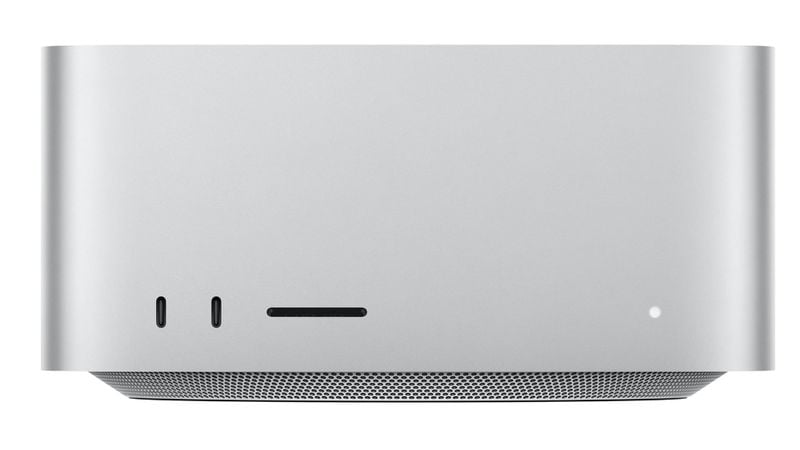
Should You Buy the Mac Studio?
The Mac Studio is one of Apple's most powerful custom Apple silicon-based Macs, offering extreme performance and a wide range of ports in a compact, desktop form factor. The Mac Studio starts at $1,999.
The Mac Studio is at the beginning of its product cycle, and it was updated with M4 Max and M3 Ultra chips in March 2025. So far, it looks like the Mac Studio is updated every two years or so, and since a refresh just happened, now is a good time to buy the Mac Studio.
While the Mac Studio is one of Apple's most powerful Macs, for a more versatile desktop machine with an interchangeable, modular design with more ports, there is the Mac Pro, which starts at $6,999. It uses the prior-generation M2 Ultra chip, though, so you might wait to wait for a refresh if that's the machine you want.
On the other hand, if the Mac Studio is out of your price range but you still want a similar Apple silicon-based desktop Mac, there is the entry-level Mac mini with the M4 chip, which starts at just $599, or the more powerful M4 Pro version that starts at $1,399.
Mac Studio Detailed
Contents
The Mac Studio is positioned as a cross between a Mac mini and a Mac Pro. The Mac Studio is aimed at "studio" professionals, as the name suggests, and it uses Apple's most powerful M-series chips, the M4 Max and the M3 Ultra. It is an alternative to the pricier Mac Pro and serves as an option for those who do not need the expandability and flexibility the Mac Pro offers.
Apple designed the Mac Studio to provide impressive performance, connectivity, and functionality in a more affordable and compact form than the Mac Pro. Apple refreshed the Mac Studio in March 2025, adding faster chips and Thunderbolt 5, but keeping the design and other specs the same.
Priced starting at $1,999, the more affordable entry-level version of the Mac Studio is equipped with an Apple M4 Max chip that features up to a 16-core CPU, up to a 40-core GPU, 16-core Neural Engine, Media Engine, 546GB/s memory bandwidth, and up to 128GB Unified Memory, and it is the same chip Apple used in the 16-inch MacBook Pro last year. The more expensive $3,999 model is equipped with a new M3 Ultra chip.
The M3 Ultra chip is essentially two M3 Max chips connected together on a single die and able to perform as one unified chip, which Apple calls UltraFusion architecture. It features up to a 32-core CPU and a 80-core GPU, along with a 32-core Neural Engine, 819GB/s memory bandwidth, up to 512GB Unified Memory, and a 2x faster Media Engine.
According to Apple, the M3 Ultra is almost 2x faster than the M4 Max when handling system intensive workloads, and it supports playback of up to 24 streams of 8K ProRes video and up to eight displays.
The Mac Studio features a square-shaped 7.7-inch all-aluminum enclosure that's 3.7-inches high. The size is meant to allow it to fit under most displays on the market, and the design has not changed between generations.
The Mac Studio is designed for quiet operation, with a unique thermal architecture that pulls air in through the airflow channels on the bottom using double-sided blowers and pushes it out through additional perforations on the back of the chassis.
There are four Thunderbolt 5 ports at the back of the Mac Studio, along with a 10Gb Ethernet port, two USB-A ports, an HDMI port, and a 3.5mm headphone jack with support for high-impedance headphones. At the front, the M4 Max Mac Studio has an additional two USB-C ports and an SDXC card slot, while the M3 Ultra has two Thunderbolt 5 ports and the same card slot.
The Mac Studio with M3 Ultra supports up to eight 6K displays at 60Hz, or four displays with 8K resolution at 60Hz.
The M4 Max version comes with a 512GB SSD and the M3 Ultra model comes with a 1TB SSD, but the M4 Max version is configurable with up to 8TB of SSD storage space and the M3 Ultra model can support up to 16TB.
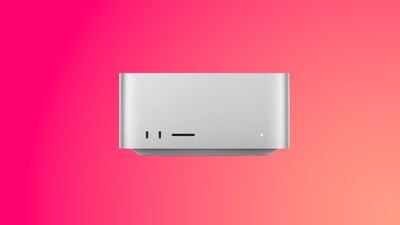
As for wireless connectivity, the Mac Studio has Wi-Fi 6E for fast Wi-Fi speeds and the option to connect to 6GHz networks, and it supports Bluetooth 5.3.
The Mac Studio can be paired with Apple's matching $1,599 Studio Display, a 27-inch 5K resolution display that has a built-in 12-megapixel camera with Center Stage support, as well as high-quality microphone and speaker arrays, or it can be used with the more expensive Pro Display XDR.
Pricing on the M4 Max Mac Studio starts at $1,999, while pricing on the M3 Ultra version starts at $3,999.
Note: See an error in this roundup or want to offer feedback? Send us an email here.
How to Buy
The Mac Studio can be ordered from the Apple website and other retailers. The M4 Max version is priced starting at $1,999, and the M3 Ultra version is priced starting at $3,999, with additional upgrade options available.
As of June 2025, Apple is offering refurbished versions of the new Mac Studio models at a discounted price.
Reviews
Reviews of the new Mac Studio have been positive, with reviewers impressed with the performance improvements that Apple introduced with the M4 Max and M3 Ultra chips.
When it comes to the CPU, if you're looking to maximize single-core performance, the M4 Max wins out over the M3 Ultra. It's single-core performance that makes apps feel speedy, while multi-core performance is what you need for system intensive tasks like 3D rendering and video editing. The M3 Ultra comes out on top for multi-core CPU performance, and it wins in GPU performance, too.
The M3 Ultra chip is overkill for most users because it is expensive and designed with professional applications in mind. It's for visual effects artists, animators, those working with LLMs, and other similar activities. It is an M3 Ultra and not an M4 Ultra, which some reviewers felt didn't seem like enough of an upgrade to choose the Ultra over the Max.
Along with new chips, Apple added Thunderbolt 5 ports to the Mac Studio, for faster transfer speeds and more importantly, more display connectivity options. The M4 Max Mac Studio supports up to four 6K external displays, and the M3 Ultra supports up to eight, plus there's support for 8K displays as well.
More Mac Studio reviews can be found in our review roundup.
Design
The Mac Studio takes design cues from both the Mac mini and the Mac Pro with an all-aluminum enclosure and unique thermal design. It uses the same "squircle" shape as the Mac mini, with a square-shaped design that has rounded corners.

It is essentially a taller version of the pre-2024 Mac mini, measuring in at 3.7 inches tall and 7.7 inches wide at each side. Apple says that it is sized to fit perfectly under most displays, including the Studio Display that Apple introduced alongside the first Mac Studio release.
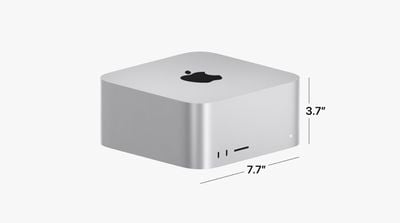
The M4 Max version of the Mac Studio weighs 6.1 pounds (2.74 kg), while the M3 Ultra version weighs 8.0 pounds (3.64 kg). The extra weight in the M3 Ultra version is largely due to a difference in thermal needs. The M4 Max version has an aluminum heatsink while the M3 Ultra version has a larger copper thermal module.
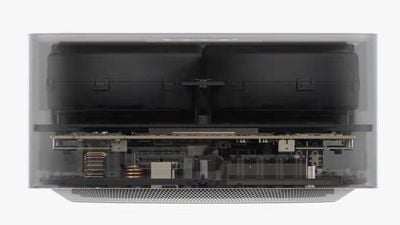
To dissipate heat and allow for quiet operation, the Mac Studio has a series of airflow channels at the back and at the bottom. The machine pulls in air from the bottom and pushes it out through the more than 4,000 perforations at the back and bottom of the chassis to cool the internal components.
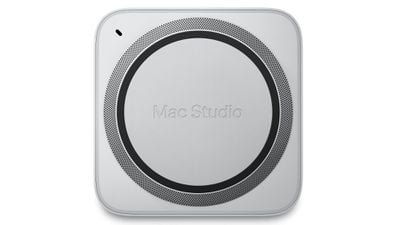
Ports
There are a total of 12 ports on the front and back of the Mac Studio. The back features four Thunderbolt 5 ports, a 10Gb Ethernet port, two USB-A ports, one HDMI port, and a 3.5mm headphone jack that supports high-impedance headphones. There is also a built-in speaker to go along with the headphone jack.
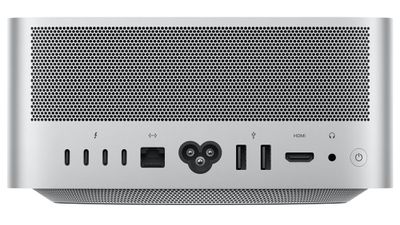
Thunderbolt 5 is a new addition this year for both Mac Studio models, as the prior versions used Thunderbolt 4. Thunderbolt 5 supports transfer speeds of up to 120Gb/s, with DisplayPort 2.1 also supported
The front of the M4 Max Mac Studio features an additional two USB-C ports along with an SDXC card slot, while the front of the M3 Ultra Mac Studio includes two Thunderbolt 5 ports and the SDXC card slot.
The M4 Max supports up to four displays with 6K resolution at 60Hz over Thunderbolt, and one display with 4K resolution at 144Hz over HDMI. Alternatively, it supports two displays with 6K resolution at 60Hz over Thunderbolt, and one display with 8K resolution 1t 60Hz over HDMI.
The M3 Ultra supports up to eight displays with 6K resolution at 60Hz or 4K resolution at up to 144Hz. Alternatively, it supports four displays with up to 8K resolution at 60Jz or 4K resolution at up to 240Hz.
Processor and Internals
The Mac Studio can be purchased with either an M4 Max or M3 Ultra chip. The M4 Max is the same chip that was first introduced in the 16-inch MacBook Pro models in 2024, while the M3 Ultra is basically two prior-generation M3 Max chips working together in tandem to form a single chip for double the performance of the M3 Max. Apple uses UltraFusion, a custom-built packaging architecture, for the M3 Ultra.
The M4 Max chip features a 14-core CPU with 10 performance cores and four efficiency cores, but it can be upgraded to a 16-core CPU. It has up to a 40-core GPU, a 16-core Neural Engine, and 546GB/s memory bandwidth, up from 400GB/s.

Apple's higher-end M3 Ultra chip essentially doubles that. It features a 28-core CPU with 20 performance cores and eight efficiency cores, with an option to upgrade to a 32-core CPU. There's up to an 80-core GPU and a 32-core Neural Engine, along with 819GB/s memory bandwidth.
Apple says that the M3 Ultra is the fastest Mac chip that it has released to date, with the Mac Studio able to tackle the most intense workloads, including AI tasks. The Mac Studio with M3 Ultra can run large language models with over 600 parameters entirely in memory, which Apple says is the most ever in a personal computer.
The M4 Max Mac Studio is up to 3.5x faster than the Mac Studio with M1 Max, and Apple says it is up to 6.1x faster than old Intel-based iMacs. Compared to M1 Max, it is up to 1.6x faster when processing images in Photoshop, 2.1x faster when compiling code in Xcode, and up to 1.2x faster when transcoding ProRes video using Compressor.
The M3 Ultra Mac Studio provides up to 2x faster performanc than the M4 Max for workloads that require high CPU and GPU core counts. It is up to 2.6x faster than the Mac Studio with M1 Ultra chip. The M3 Ultra is up to 16.9x faster at LLM token generation than M1 Ultra, up to 2.6x faster rendering scenes in Maxon Redshift, and up to 1.4x faster when rendering 8K video in Final Cut Pro.
In early benchmarks, the M3 Ultra earned a multi-core score of 28,160, which suggests it is approximately 10 percent faster than the M4 Max and 30 percent faster than the M2 Ultra chip. The M4 Max offers 20 percent faster single-core performance because it is based on a newer 3nm process.
In a GPU test, it earned a Metal score of 259,668, which is 16 percent faster than the M2 Ultra GPU. A maxed out Mac Studio with an M3 Ultra chip and 512GB RAM is capable of running the 671 billion parameter DeepSeek R1 AI model locally.
Both the M4 Max and the M3 Ultra support Dynamic Caching, hardware-accelerated ray tracing, and mesh shading. Dynamic Caching allocates the use of local memory in hardware in real time, so only the exact amount of memory needed is used for each task. It increases the average utilization of the GPU, thereby increasing performance for demanding pro apps and games.
With hardware-accelerated ray tracing, light looks more realistic as it interacts with a scene, allowing for more physically accurate images. Game developers can use the ray-tracing and mesh shading for more accurate shadows and reflections as well as more efficient geometry processing.
Low Power Mode
Apple added a Low Power Mode option to the M3 Ultra version of the Mac Studio, which is designed to reduce fan noise for work that requires a quiet environment. Low Power Mode also cuts down on power consumption if the machine is running continuously.
The Mac Studio models do not have the High Power Mode option that's available for the MacBook Pro and Mac mini. High Power Mode allows a Mac's fans to run at higher speeds for graphics-intensive sustained workloads.
Media Engine
The Media Engine in the M4 Max and M3 Ultra offers dedicated acceleration for the ProRes video codec, along with video encode/decode engines and hardware accelerated support for H.264, HEVC, ProRes, and ProRes RAW.
The M4 Max has a video decode engine, AV1 decode, two video encode engines, and two ProRes encode and decode engines, while the M3 Ultra has double that.
Unified Memory
The M4 Max Mac Studio supports up to 128GB unified memory when equipped with a 40-core GPU (64GB on the 32-core GPU version), while the M3 Ultra Mac Studio supports up to 512GB unified memory with the high-end model.
Storage
The M4 Max Mac Studio supports up to an 8TB SSD, while the M3 Ultra Mac Studio supports up to a 16TB SSD, double the storage maximum of the prior model. The M4 Max Mac Studio comes with a 512GB SSD by default, while the base M3 Ultra Mac Studio ships with a 1TB SSD.
Connectivity
The Mac Studio models support the faster 802.11ax WiFi 6E connectivity, which is able to connect on the quicker 6GHz band when a compatible network is available. It also supports Bluetooth 5.3, which is the latest Bluetooth protocol.
Available Models
There are two base Mac Studio configurations available from Apple, one with an M4 Max chip and one with an M3 Ultra chip.
- $1,999 - M4 Max chip with 14-core CPU, 32-core GPU, and 16-core Neural Engine. 32GB unified memory, 512GB SSD, and two front USB-C ports.
- $3,999 - M3 Ultra chip with 28-core CPU, 60-core GPU, and 32-core Neural Engine. 96GB unified memory, 1TB SSD, and two front Thunderbolt 5 ports.
Build-to-Order Upgrades
Base Model Mac Studio Upgrade Options
Processor
- M4 Max w/ 14-core CPU, 32-core GPU, 16-core Neural Engine - +$300
- M3 Ultra w/ 28-core CPU, 60-core GPU, 32-core Neural Engine - +$1,000
- M3 Ultra w/ 32-core CPU, 80-core GPU, 32-core Neural Engine - +$2,500
Memory
- 48GB unified memory - +$200
- 64GB unified memory - +$400
- 96GB unified memory - +$800 (M3 Ultra required)
- 128GB unified memory - +$1,200
- 256GB unified memory - +$2,400 (M3 Ultra required)
- 512GB unified memory - +$4,800 (M3 Ultra required)
SSD
- 1TB SSD - +$200
- 2TB SSD - +$600
- 4TB SSD - +$1,200
- 8TB SSD - +$2,400
- 16TB SSD - +$4,600 (M3 Ultra required)
Higher-end Mac Studio Upgrade Options
Processor
- M3 Ultra w/ 32-core CPU, 80-core GPU, 32-core Neural Engine - +$1,500
Memory
- 256GB unified memory - +$1,600
- 512GB unified memory - +$4,000
SSD
- 2TB SSD - +$400
- 4TB SSD - +$1,000
- 8TB SSD - +$2,200
- 16TB SSD - +$4,600
Studio Display
Apple introduced the first version of the Mac Studio alongside the Studio Display, a 27-inch 5K display that's designed to be used with it. The Studio Display is compatible with other Macs and iPads, but it was designed to match the Mac Studio, and Apple still promotes the Mac Studio and Studio Display as the "dream team."
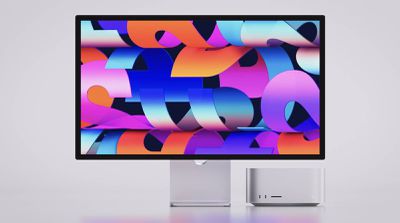
The Studio Display features a built-in A13 chip that powers a 12-megapixel Ultra Wide camera with Center Stage and a six-speaker sound system with Spatial Audio, plus it includes a studio-quality three-microphone array and a tilt and height adjustable stand option. More information on the Studio Display can be found in our dedicated roundup.

